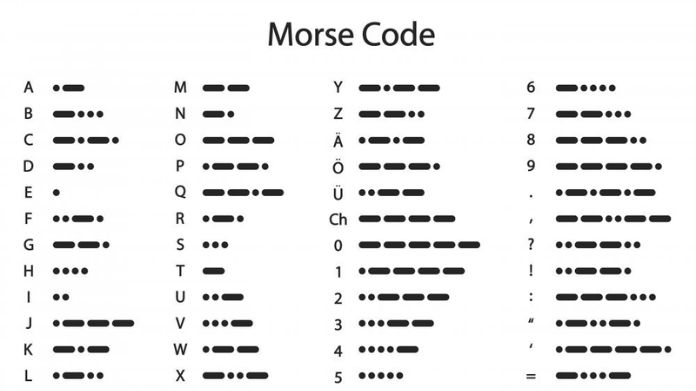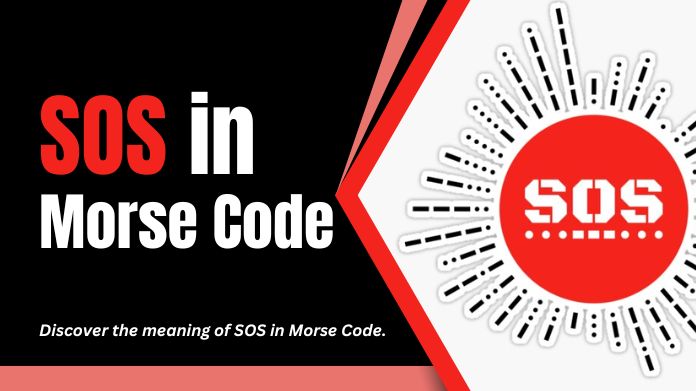Effective conversation can mean the difference between life and death in emergencies. Because of its simplicity and lengthy history, Morse code has been an essential communication tool in these circumstances.
The Morse code sequence “SOS,” which stands for “distress,” is among the most well-known. SOS in Morse code is a distress signal in emergencies like plane crashes and shipwrecks. But “Save Our Ship” or “Save Our Souls” is not what SOS stands for.
There is no direct translation for SOS; it was never meant to be an acronym. Instead, the letters S and O were chosen because of their uniqueness and simplicity. SOS is simple to identify and transmit in an emergency since it doesn’t look like any other code or signal.
Are you curious about the background of Morse code? Continue reading! In this Morse code translator guide, we will explore the meaning of SOS in Morse code, its background, and how to write it.
By the end, you’ll fully grasp SOS Morse code and its significance.
What is Morse Code?

An important turning point in long-distance communication development was the early 1830s when Samuel Morse and Alfred Vail collaborated to create the Morse code.
This ground-breaking system unveiled a novel information encoding and transmission technique over long distances. All of the language, letters, numbers, and symbols included are represented in the Morse code system using an ingenious arrangement of dots and dashes, each with a unique meaning and function.
Even though modern communication technologies are widely integrated into our daily lives, Morse code is still handy, particularly in emergencies and other critical situations.
Its simplicity and ease of application qualities that have continuously aided humanity in complex and uncertain times give it its resilience as an effective message-conveying medium.
What is the Morse Code Alphabet?
The entire Morse code alphabet must be familiarized before you can comprehend SOS in Morse code. This is the whole chart for Morse code.
- A: .- N: -. 0: —–
- B: -… O: — 1: .—-
- C: -.-. P: .–. 2: ..—
- D: -.. Q: –.- 3: …–
- E: . R: .-. 4: ….-
- F: ..-. S: … 5: …..
- G: –. T: – 6: -….
- H: …. U: ..- 7: –…
- I: .. V: …- 8: —..
- J: .— W: .– 9: —-.
- K: -.- X: -..-
- L: .-.. Y: -.–
- M: — Z: –..
What is SOS in Morse Code?

The SOS signal was first used as a distress call in the early 1900s. A few distress signals were used before SOS, but none had gained widespread use.
SOS was selected because it is straightforward to transmit. It was soon acknowledged as the global norm for voice radio communications and Morse code distress calls.
What is the Meaning of SOS in Morse Code?
The distress signal in Morse code, SOS, was selected because it is straightforward to identify. It consists of three short signals (three dots), three longer signals (three dashes), and three additional short signals in succession.
Both seasoned and inexperienced operators could easily recognize this distinctive pattern under pressure. The SOS signal is widely acknowledged as a distress signal in both voice and Morse code communications.
The International Radiotelegraphic Convention in 1906 formalized its adoption as a global standard. Since then, various emergency scenarios, including maritime mishaps and mountaineering mishaps, have been addressed by using SOS to request prompt assistance.
How to Write SOS in Morse Code?
Let’s look at the Morse code chart before we write SOS in Morse code. One must be familiar with the codes for each letter and number to compose SOS accurately.
Steps to Write SOS in Morse Code
To write SOS in Morse code, follow these steps.
Step 1- Start with the letter “S,” represented by three short signals: “…”
Step 2- Follow “S” with the letter “O,” which consists of three longer signals: “—“
Step 3- Conclude with the letter “S” again, using three short signals: “…”
Final Result – In Morse code, SOS is written as “… — …”
How to Use SOS in Morse Code?
SOS is only to be used in emergency and highly distressing situations. It should not be used carelessly as it may cause neighbouring vessels or emergency services to respond. These are essential guidelines to adhere to when using SOS.
Use the appropriate signal: Ensure you send the SOS in Morse code correctly, as previously demonstrated.
As needed, reiterate: Send out SOS messages continuously until you hear back or help shows up. Persistence is key because it’s possible that rescuers won’t notice your distress signal right away.
Signal visually and audibly: Both visual and auditory cues should be used when signaling to increase the likelihood of being noticed.
Stay alert: As you wait for assistance, stay alert and ready for any reaction or possible rescue.
Conclusion
This extensive guide has examined SOS’s origins, importance, and real-world uses in Morse code. SOS is still a symbol of hope and assistance in times of need, starting as a straightforward and efficient distress signal and continuing to be relevant in contemporary emergency communication.
Even though technology has given us access to more sophisticated forms of communication, reading and writing SOS in Morse code can be useful in emergencies where more conventional means of communication are ineffective.
The SOS signal, represented in Morse code, is a signal that goes beyond time and technology to remind people of the value of being ready and sticking together in the face of difficulty, whether they are sailors, pilots, outdoor enthusiasts, or just someone interested in the history of communication.
